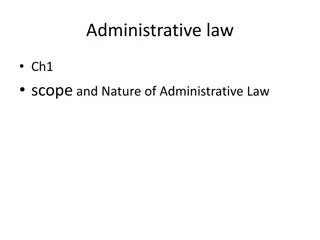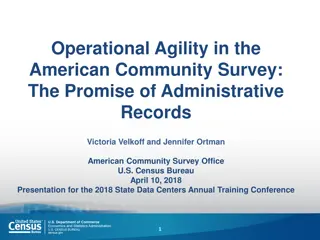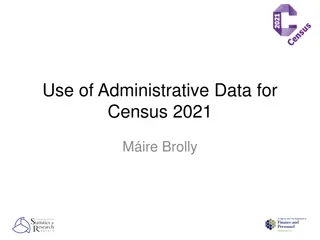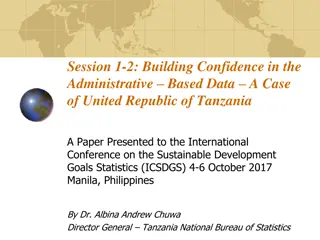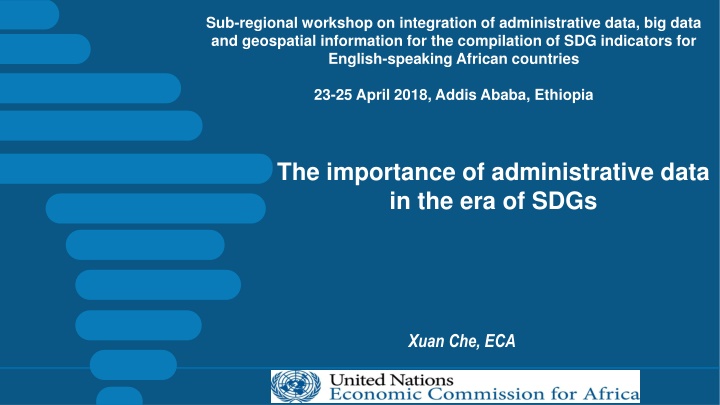
Importance of Administrative Data in SDG Implementation for African Countries
Explore the significance of administrative data in the context of Sustainable Development Goals (SDGs) for English-speaking African countries. Learn about the various types of administrative data, advantages of using it, trends, considerations, and integration methods for effective SDG tracking and implementation.
Download Presentation

Please find below an Image/Link to download the presentation.
The content on the website is provided AS IS for your information and personal use only. It may not be sold, licensed, or shared on other websites without obtaining consent from the author. If you encounter any issues during the download, it is possible that the publisher has removed the file from their server.
You are allowed to download the files provided on this website for personal or commercial use, subject to the condition that they are used lawfully. All files are the property of their respective owners.
The content on the website is provided AS IS for your information and personal use only. It may not be sold, licensed, or shared on other websites without obtaining consent from the author.
E N D
Presentation Transcript
Sub-regional workshop on integration of administrative data, big data and geospatial information for the compilation of SDG indicators for English-speaking African countries 23-25 April 2018, Addis Ababa, Ethiopia The importance of administrative data in the era of SDGs Xuan Che, ECA
The importance of administrative data in the era of sdg African Centre for Statistics United Nations Economic Commission for Africa April 2018
The many different types of administrative data Definition Administrative records are data collected for the purpose of carrying out various non-statistical programs. Types of administrative data - Custom record: the flow of goods and people across borders. - Legally required registration on events such as births and deaths. - Social Security records. - Tax records. - Crime reports and law enforcement records. - Housing data. - Permit, etc. - And much, much more.
The advantages of using administrative data by NSS It is cost-effective. It is quality assured. It is up-to-date. It has lower burden to both the NSS and the respondents.
Trend of Using Administrative Data UNSD advocates the use of administrative data for many years (workshops). European Statistical Law: Revised in 2015 with an emphasis on Free access for National Statistical Institutes (NSIs) to administrative records. In Africa, the Addis Ababa Action Agenda of the Third International Conference on Financing for Development declared: National statistical systems have a central role in generating, disseminating and administering data. They should be supplemented with data and analysis from civil society, academia and the private sector.
The considerations of using administrative data for the SDG Administrative data can be used for producing dis-aggregated data for specific population groups, that are too small or too difficult to be captured by conventional data collection means. Using administrative data for SDG tracking, one need to consider: - Record linkage - Accessibility - Confidentiality - Nonresponses - Documentation
Ways of integrating administrative data into SDG tracking Directly Link with other registers Combined with surveys and big data As sampling frames For quality control purposes Implications to Africa
Numbers of indicators with full or partial administrative data sources for each Goal 30 15% 25 8% 17% 20 24% 15 20% 14% 15% 29% 50% 25% 10 36% 45% 13% 5 0 SDG 1 SDG 2 SDG 3 SDG 4 SDG 5 SDG 6 SDG 8 SDG 9 SDG 11 SDG 13 SDG 15 SDG 16 SDG 17 Indicators with administrative data sources
SDG Metadata Analysis: Selected examples 1.a.2 Proportion of total government spending on essential services (education, health and social protection) 2.4.1 Proportion of agricultural area under productive and sustainable agriculture 4.c.1 Proportion of teachers in: (a) pre-primary; (b) primary; (c) lower secondary 11.5.1 Number of deaths, missing persons and persons affected by disaster per 100,000 people 17.1.2 Proportion of domestic budget funded by domestic taxes
SDG Metadata Analysis: Selected examples SDG3: Good Health and Well-being - Health services Hospital, family planning; - Suicide rate, death rate by traffic injuries Police. SDG5: Gender Equality - CRVS. SDG11: Sustainable Cities and Communities - Housing, transport, public spendings.
SDG Metadata Analysis: Selected examples SDG15: Life on Land - SDG15.7.1: Proportion of traded wildlife that was poached or illicitly trafficked Border and custom. SDG16: Peace, Justice and Strong Institutions - SDG16.1.1: Number of victims of intentional homicide per 100,000 population, by sex and age - Law enforcement. - SDG16.3.2: Un-sentenced detainees as a proportion of overall prison population - Prison administration.
Current status: administrative data are not fully utilized Generally the main reasons administrative data are not fully utilized by countries are: Inclination of NSOs to always conduct surveys in the countries. Quality - coverage, standard of use from administrations, timeliness for production and dissemination. NSS s access to raw, micro-level administrative data. Issue of confidentiality. Lack of collaboration: production of administrative data requires cooperation on all levels: - Cooperation between government agencies - Cooperation between public and private data providers - Cooperation between users - International cooperation.
The Way Forward NSS should have good knowledge on existing administrative data in their respective countries. Inventory of administrative data should be accessible for all, to build framework for accessible use for all. Better coordination of planning, implementing programs of admin data from all government agencies, NSO should be involved and consulted from the very beginning, and when data are reviewed. New technology for collecting data and technology improvements. Continuous training and capacity building. Law of statistics - Statistics authorities should be involved in the registries of administrative data. - Regulations and policies should be enhanced to provide free access of administrative data to the statistical authorities.
Thank you! Xuan Che che@un.org












